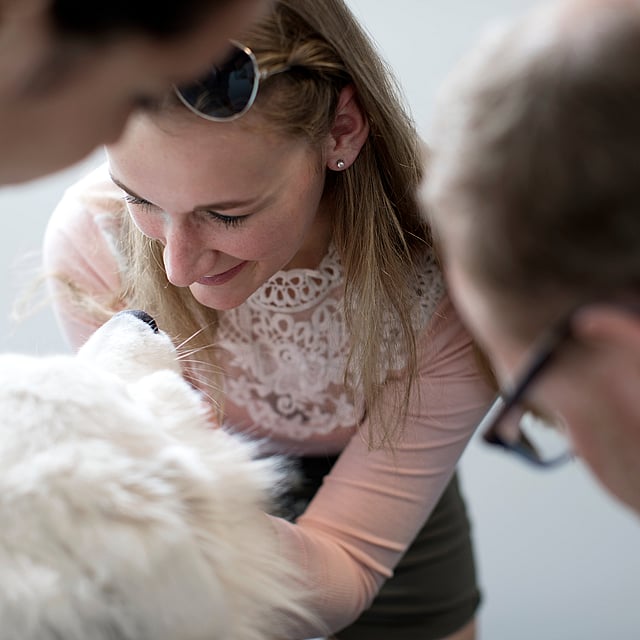If you need to visit a clinic, you can go to your most recently visited clinic or choose to find another.
What is a breeding soundness examination in dogs?
If a dog, male or female, is to be used for breeding, a breeding soundness examination beforehand by a vet is highly advisable. This looks for the presence of various hereditary diseases. Depending on the breed and breed association, these examinations may be essential for participation in official breeding. The tests follow a standardised protocol and the results are summarised in a corresponding report. This is often sent directly by the vet to the respective breed association.
Breeding soundness examination procedure
The dogs first have a thorough clinical examination in which the vet uses his five senses initially: observation of the skin and coat, eyes and teeth, listening with a stethoscope and feeling e.g., the belly, teats or testicles.
Imaging methods such as ultrasound and X-ray are also used. In addition, contrast agents are used in examining the urinary tract system to show the route of the urine on X-ray. An anaesthetic is necessary for some tests, e.g., X-rays to diagnose hip dysplasia. Apart from investigations of different organs, there are blood tests for some hereditary diseases that are then done in addition.
What breeding soundness examinations are done in dogs?
Depending on the breed of dog, certain organ systems are examined in detail. Please find out from the relevant breed association which tests are needed.
The examined organ systems include:
Locomotor system
in particular, examination for hip dysplasia / elbow dysplasia and patellar (kneecap) luxation
Eyes
possible hereditary eye diseases include, for instance,
- Cataract (clouding of the lens)
- Glaucoma, elevation of intraocular pressure with subsequent blindness
- Entropion/ectropion (lid deformity)
- Horner’s syndrome (nerve damage with typical symptoms)
Heart and circulation
a precise examination of the heart by auscultation and ultrasound, and sometimes by ECG (electrocardiogram) also, is important. This identifies malformations of the great vessels or other cardiac abnormalities, which are often hereditary. The heart in particular should be examined regularly in later years as there are degenerative diseases of the heart that develop slowly and only become visible later, but which are hereditary.
Inherited heart diseases include, for example,
- Septum defects (openings in the cardiac septum that do not close during development, thereby interfering with normal function)
- Heart valve defects (the valves do not close completely or the passage through which blood flows is narrowed)
- Hypertrophic cardiomyopathy (thickening of the heart muscle)
- Dilated cardiomyopathy (enlargement of the heart)
Urogenital system
the sex and urinary organs are examined precisely with an ultrasound scan. Particular attention is paid to ectopic ureters, a malformation of the ureters in which the urine flows to other organs instead of to the bladder. Malformations of the kidneys can also be identified.
Important
Get in touch with your vet before your dog’s examination for breeding soundness. Should an anaesthetic be necessary, the dog must be fasting. Always brings the dog’s pedigree with you to the examination as well as any other breed association’s forms so that the results can be entered directly. If your dog has not yet been microchipped, this will be done on the day of the breeding soundness examination so that he can be clearly identified.
A breeding soundness examination not only reduces the risk of the offspring suffering from hereditary diseases but naturally also offers the chance that diseases in your pet can be identified and treated in good time.
© AniCura
Most recent clinic
If you need to visit a clinic, you can go to your most recently visited clinic or choose to find another.
